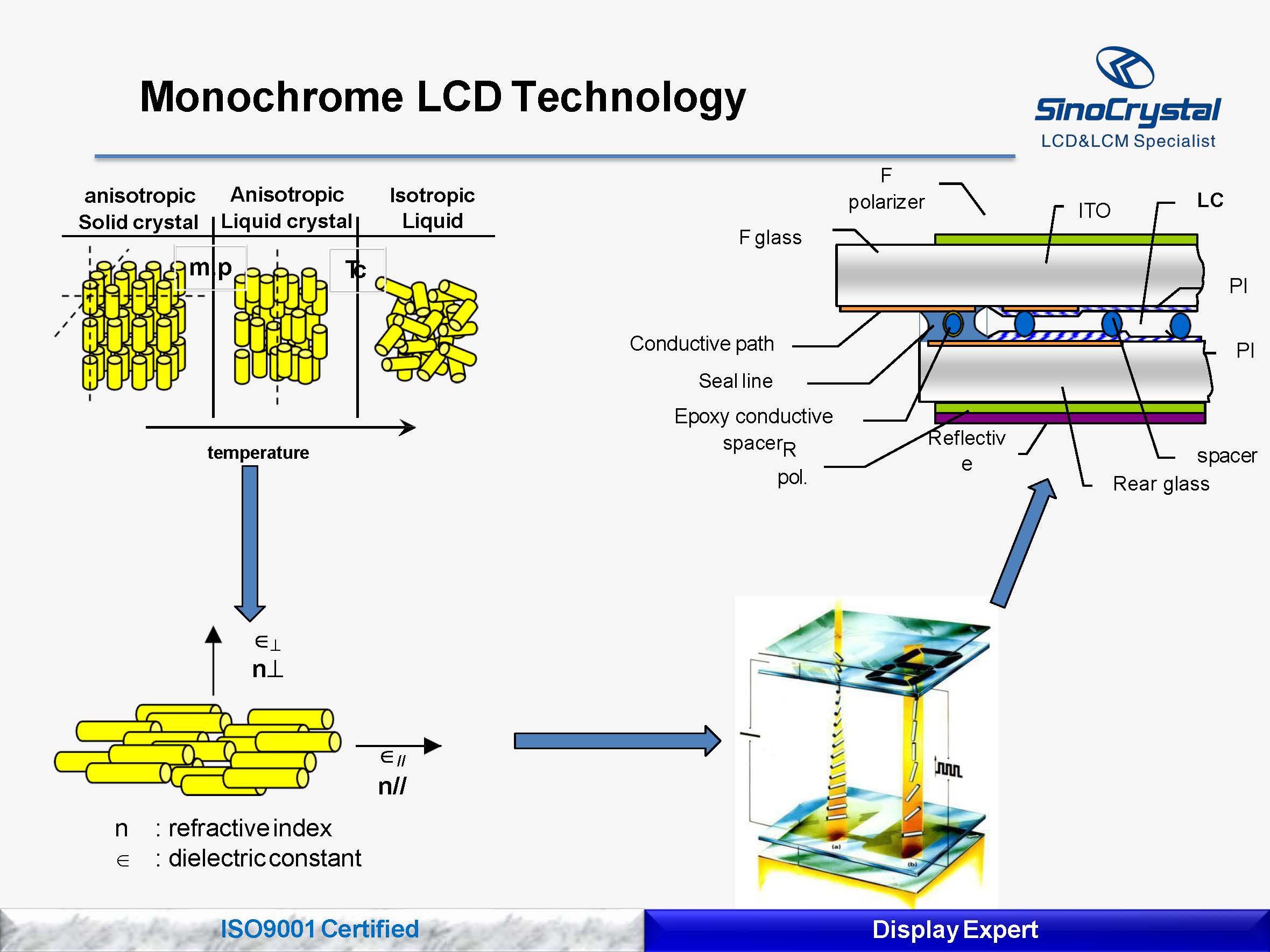Monochrome LCD Display Technology

Mono LCD technology is actually to pour liquid crystal into two rows of flat surfaces with fine grooves. The grooves on these two planes are perpendicular to each other (the intersection becomes 90°). Then, if the molecules on one plane are arranged in the north-south direction, the molecules on the other plane are arranged in the east-west direction, and the molecules located between the two planes are directly forced into a 90° twisted state. Since light travels along the direction in which the molecules are arranged, the light must be twisted 90° when passing through the liquid crystal. But when we apply a voltage to the liquid crystal, the molecules will be re-arranged vertically so that the light can be emitted directly without any twisting.
LCD is very dependent on the polarization filter (plate) and the light itself. In reality, natural light diverges randomly in all directions. The polarized filter is actually a series of increasingly thinner parallel lines. These lines form a net, blocking all light that is not parallel to these lines. The line of the polarization filter is exactly perpendicular to the first one, so it can completely block the light that has been polarized. Only when the lines of the two filters are completely parallel, or the light itself has been twisted to match the second polarization filter, can the light penetrate.
LCD is composed of such two polarized filters that are perpendicular to each other, so under normal circumstances, all light that attempts to penetrate should be blocked. However, because there are many twisted liquid crystals between these two filters, after the light successfully passes through the first filter, it will be forced to twist 90 degrees by the liquid crystal molecules, and finally filtered from the second one. Out of the optical device. On the other hand, if a voltage is applied to the liquid crystal, the molecules will be rearranged and completely parallel, so that the light will not be twisted anymore, so it happens to be blocked by the second filter. In short, power on will block light, and no power on will cause light to escape.
However, the arrangement of the liquid crystals in the LCD can be changed so that the light is emitted when power is applied, and is blocked when power is not applied. But because the screen of the computer is almost always on, only the solution of “power on and block the light” can ultimately achieve the most power saving purpose.
From the perspective of the working principle of the LCD screen display, whether it is a notebook computer or a desktop system, the LCD display used is actually a layered structure composed of different parts. The LCD is composed of two glass plates with a thickness of approximately 1 mm. The two glass plates are separated by a uniform interval of 5 μm containing liquid crystal (LC) materials. Because the liquid crystal material itself does not emit light, there will be lamps as the light source on both sides of the display screen, and on the back of the liquid crystal display there is a backlight plate (also called a homogenizing plate), a reflective film, and a backlight plate. It is composed of fluorescent materials and can emit light. Its main function is to provide a relatively uniform background light source. The light emitted by the backlight will enter the liquid crystal layer containing thousands of crystal droplets after passing through the first polarizing filter layer. The crystal droplets in the liquid crystal layer are all contained in a small cell structure, and one or more cells can form a pixel on the screen. Between the glass plate and the liquid crystal material is a transparent electrode. The electrode is generally divided into rows and columns. At the intersection of the rows and columns, the optical rotation state of the liquid crystal can be changed by changing the voltage. The function of the liquid crystal material is similar to a A relatively small light valve. Around the liquid crystal material is the control circuit part and the drive circuit part. When the electrodes in the LCD generate an electric field, the liquid crystal molecules will be twisted, so that the light passing through it will undergo a regular refraction, and then it will be filtered by the second filter layer to appear on the screen.
The 8 inch displays might be affected and delay for an accident.
New iPhone 13 Series will use On-Cell OLED Displays. And it that will be launched in the second half of this year will be exclusively supplied by Samsung Display (SDC)
This is the project management of how sinocrystal handle your customized project relate to displays.
Discover how LCD displays are evolving in industrial automation — from high-brightness and rugged designs to smart connectivity and energy efficiency. Explore what’s next for industrial-grade visual interfaces.
Discover the key factors to consider when choosing an LCD display for your project, including size, resolution, interface, brightness, and customization options from a factory-direct manufacturer.
Discover the latest innovations in rugged LCD displays for harsh environments — from extreme temperature resistance to sunlight readability and waterproof designs. Factory-direct manufacturing with full customization.
A complete guide to LCD display connection methods, including SPI, I2C, RGB, MIPI, LVDS interfaces and physical mounting options. Learn how to connect monochrome and TFT LCDs to your development board or product housing.